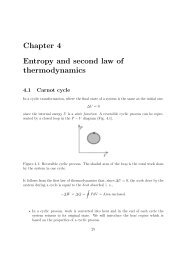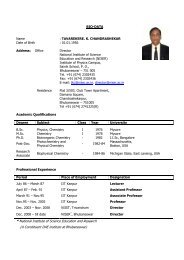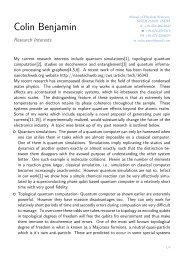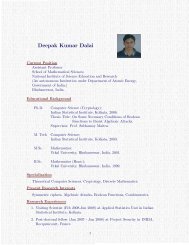5.3.03-00 Hall effect in metals Physical structure of matter - niser
5.3.03-00 Hall effect in metals Physical structure of matter - niser
5.3.03-00 Hall effect in metals Physical structure of matter - niser
You also want an ePaper? Increase the reach of your titles
YUMPU automatically turns print PDFs into web optimized ePapers that Google loves.
Fig. 3: <strong>Hall</strong> voltage as a function <strong>of</strong> magnetic <strong>in</strong>duction B,<br />
us<strong>in</strong>g a copper sample.<br />
The measurements shown <strong>in</strong> Fig. 4 confirm for copper the<br />
relation UH � I L<strong>in</strong>ear regression with the relation UH a + bI<br />
yields a straight l<strong>in</strong>e with slope b = – 0.770 · 10 -6 V/A and<br />
standard deviation sb = 0.<strong>00</strong>5 · 10-6 V/A. From this, with<br />
d =18· 10 -6 m and B = 0.25 T, we derive the <strong>Hall</strong> coefficient<br />
RH = – (0.554 ± 0.<strong>00</strong>4) · 10-10 m3 /As.<br />
Fig. 4: <strong>Hall</strong> voltage as a function <strong>of</strong> current I, us<strong>in</strong>g a copper<br />
sample.<br />
<strong>Hall</strong> <strong>effect</strong> <strong>in</strong> <strong>metals</strong><br />
LEP<br />
<strong>5.3.03</strong><br />
-<strong>00</strong><br />
Fig. 5: <strong>Hall</strong> voltage as a function <strong>of</strong> magnetic <strong>in</strong>duction B,<br />
us<strong>in</strong>g a z<strong>in</strong>c sample.<br />
The z<strong>in</strong>c sample shows an anomalous <strong>Hall</strong> <strong>effect</strong>, <strong>in</strong> that the<br />
<strong>Hall</strong> voltage has a positive sign. The measurements shown <strong>in</strong><br />
Fig. 5 confirm for z<strong>in</strong>c the relationship UH � B. L<strong>in</strong>ear regression<br />
us<strong>in</strong>g the expression UH = a + bB gives a straight l<strong>in</strong>e with slope<br />
b = 20.7·10 -6 m2 /s and standard deviation sb = 0.4·10-6 m/s.<br />
From this, with d = 25·10 -6 m and I = 12 A, we obta<strong>in</strong> the <strong>Hall</strong><br />
coefficient<br />
RH = (4.31 ± 0.01) · 10-11 m3 /As.<br />
Fig. 6: <strong>Hall</strong> voltage as a function <strong>of</strong> current I, us<strong>in</strong>g a z<strong>in</strong>c<br />
sample.<br />
PHYWE series <strong>of</strong> publications • Laboratory Experiments • Physics • © PHYWE SYSTEME GMBH & Co. KG • D-37070 Gött<strong>in</strong>gen 25303-<strong>00</strong> 3<br />
mV<br />
mV







